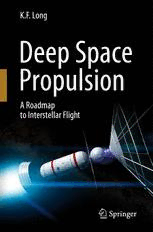
Deep Space Propulsion: A Roadmap to Interstellar Flight PDF
Preview Deep Space Propulsion: A Roadmap to Interstellar Flight
Deep Space Propulsion K.F. Long Deep Space Propulsion A Roadmap to Interstellar Flight K.F.LongBsc,Msc,CPhys VicePresident(Europe),IcarusInterstellar FellowBritishInterplanetarySociety Berkshire,UK ISBN978-1-4614-0606-8 e-ISBN978-1-4614-0607-5 DOI10.1007/978-1-4614-0607-5 SpringerNewYorkDordrechtHeidelbergLondon LibraryofCongressControlNumber:2011937235 #SpringerScience+BusinessMedia,LLC2012 Allrightsreserved.Thisworkmaynotbetranslatedorcopiedinwholeorinpartwithoutthewritten permissionof the publisher (SpringerScience+Business Media, LLC, 233 SpringStreet, New York, NY10013,USA),exceptforbriefexcerptsinconnectionwithreviewsorscholarlyanalysis.Usein connectionwithanyformofinformationstorageandretrieval,electronicadaptation,computersoftware, orbysimilarordissimilarmethodologynowknownorhereafterdevelopedisforbidden. Theuseinthispublicationoftradenames,trademarks,servicemarks,andsimilarterms,evenifthey arenotidentifiedassuch,isnottobetakenasanexpressionofopinionastowhetherornottheyare subjecttoproprietaryrights. Printedonacid-freepaper SpringerispartofSpringerScience+BusinessMedia(www.springer.com) This book is dedicated to three people who have had the biggest influence on my life. My wife Gemma Long for your continued love and companionship; my mentor Jonathan Brooks for your guidance and wisdom; my hero Sir Arthur C. Clarke for your inspirational vision – for Rama, 2001, and the books you leave behind. Foreword We live in a time of troubles. It is easy to name a few of them: endless wars, clashesofcultures,nuclearproliferation,overpopulation,globalclimatewarming, economicrecession,politicaldisarray. Itisalsoeasytogiveupandconcludethat allishopelessforourcivilizationandpossiblyforallhumanity. However,issuchpessimismtrulywarranted?Theyear2010witnessedthefirst reasonablysoliddetectionofpotentiallyhabitableworldscirclingnearbystars.Our understanding of the variety of life forms that could inhabit these worlds has also beenbroadened. Perhaps more significantly, another milestone of 2010 was the first successful flighttestofanon-rocketpropulsionsystemthatcouldsomedayevolveintoastar drive.True–thesolarsailsthatmayevolvefromthesuccessfulinterplanetarytest flight of the Japanese Ikaros probe will never achieve the performance of Star Trek’smythicalEnterprise–buttheyrepresentastart. Progresstowardscontrolledthermonuclearfusioncontinues.AndattheCERN laboratory on the Italian-Swiss border, the Large Hadron Collider is now opera- tional. It is not impossible that advances in our understanding of particle physics promptedbyexperimentsatthisnewfacilitywillultimatelyleadtoourtamingof theantimatter/matterannihilation.Maybesometheoreticalbreakthroughwillactu- ally lead to a warp drive or a means of tapping the enormous energies of the universalvacuum. It is impossible to know which of these new technologies – sails, fusion, or antimatter – will lead to the first human probes and ships capable of crossing the interstellar gulfs. But if you are interested in participating in the adventure of expanding the terrestrial biosphere into new realms, this book is an excellent placetohoneyourskills. The author is a major contributor to the British Interplanetary Society Project Icarus, which is investigating near-term techniques that might lead to probes capable of reaching our Sun’s nearest stellar neighbors. As well as reviewing the current state of interstellar propulsion technologies, Kelvin Long provides an extensive bibliography that will be an invaluable aid to the novice researcher. vii viii Foreword Chapter exercises are also included so that young engineers and physicists can practicetheirskills. Historical discussions regarding the evolution of flight within and outside Earth’s atmosphere will be of great interest to the casual reader. References to science fiction demonstrate the significance of literature in inspiring much of the scientific inquiry that has led us to the threshold of galactic citizenship. And the colorplatespresentthebeautifulworkofspaceartistsandillustrators. Onlyafewhumanshavefeltthecrunchoflunarsoilsbeneaththeirbootedfeet. Asomewhatlargernumberhaveremotelycontrolledtheirrovingvehiclesasthey crossthedesertsofMarsorcommunicatedwithVoyagerprobesnowonthefringe ofgalacticspace.Inalllikelihood,onlyafewwillcontrolourinterstellarrobotsand fewerstillwillridethegalactichighroadtoournextstellarhomes.Butthisbook allowsmanytocontributetoandshareintheadventure. Just maybe today’s interstellar pioneers will help stem the tide of pessimism. Perhaps, just perhaps, books like this may help develop a welcome sense of optimismandfeelingofhopeamongthereaders. NewYorkCityCollegeofTechnology,CUNY Dr.GregMatloff Preface Twolightsforguidance.Thefirst,ourlittleglowingatomof community,withallthatitsignifies.Thesecond,thecoldlight ofthestars,symbolofhypercosmicalreality,withitscrystal ecstasy.Strangethatinthislight,inwhicheventhedearestlove isfrostilyassessed,andevenpossibledefeatofourhalf-waking worldiscontemplatedwithoutremissionofpraise,thehuman crisisdoesnotlosebutgainssignificance.Strange,thatitseems more,notless,urgenttoplaysomepartinthisstruggle,this briefeffortofanimalculesstrivingtowinfortheirracesome increaseofluciditybeforetheultimatedarkness. OlafStapledon This book is about robotic exploration of the nearby stars and the prospects for achievingthiswithinthenextcentury.Inparticular,wewillfocusonthepropulsion technology that will be used to accomplish such an ambitious objective. This is so called ‘game changing’ technology that goes beyond conventional chemical rockets, using exotic fuels and more efficient engines for the purpose of an interstellar mission. This includes ideas for engines based upon harnessing the emittedenergyoftheSun,usingfusionreactionsoreventappingtheenergyrelease from matter-antimatter annihilation reactions. This book serves as an essential primerfor anyone new tothis field who wishes to become familiar with the ideas thathavealreadybeendevelopedandhowtoattainthenecessarytheoreticaltools tocreatesimilarideasforthemselves.If,bytheendofthisbook,youarethinkingof your own ideas for how machines can be propelled across the vastness of space, thenthisbookwillhavebeensuccessfulinitsultimateaim. Atthedawnofthisnewmillenniumwecan lookback ontheprevious century with pride, knowing that humanity took its first steps into space and even walked upon the surface of the Moon. We have collected a wealth of data on the many planets and moons of our Solar System, and our robotic ambassadors are still pioneering the way so that one day humans may hope to follow where they lead. TheMoonandMarsarethecurrentfocusofhumanambitionsinspace,andthisis ix x Preface rightfortheshort-termgoalsofourspecies.Butinthelongterm,missionstoplaces muchfurtherawaywillbecomenotjustaspirationsbutvitaltooursurvival. From the outset of thistext, we must betruthfulandadmitthat the technology toenable human transporttootherstarsis currently immature.Thephysics,engi- neeringandphysiologicalrequirementsareunlikeanythingwehaveeverencoun- tered,andthisuniqueproblemdemandsourfullattentionifwearetoevercrossthe enormous gulfs of space that separate the stars in our galaxy and become a truly spacefaringcivilization. But if we are bold andeventually attemptthis, the scien- tific,economicandspiritualrewardswillbemany,andourcivilizationwillbecome enriched for the attempt. Until then, we must be content with robotic exploration and to push that technology to its limit. We must continue to launch missions to theouterplanetsofourSolarSystemtoexplorethosecoldbutinterestingworlds. Eventually, our robotic probes will break through the termination shock of the solar heliosphere and pass out into the Kuiper Belt to explore many strange new dwarf planets, some perhaps yet undiscovered. Then they will be sent to much further distances out into the Oort Cloud to investigate the myriad of comets that orbit our Solar System in large period trajectories. Finally those same robots will entertheouterreachesoftheinterstellarmedium,thediffusenebulaofspacethatis dispersedbetweenthestars,andforthefirsttimeinhistoryahumanmademachine wouldhavefullyleftthegravitationalcradleofourSun. Bythistime,thetechnologyperformanceofourmachinesshouldhaveimproved by many orders of magnitude so that missions to the nearest stars will become possible and scientific data return will become common. What will those probes discover?Perhapsunusualplanetswithoceansmadeofmaterialsthoughtimpossi- blewherelifemightbeswimmingamongitsdepths.Theastronomicalknowledge gained will be highly valuable; the chance to be so close to another star and its orbiting worlds will enrich our knowledge of the universe and give us a better understandingofitsstructure,evolutionandorigin. Afew momentsspent thinking about the interstellar transportproblem quickly leadstotherealizationthattherearetwomainextremestoreachingthestars.We canbuildverylightweightvehicleswithalimitedpayloadsizeinthehopethattheir smallmassallowsforlargespeeds,suchasasolarsail.Alternatively,wecanbuild massivevehiclesthesizeofsmallmoons,whichwillmoveslowlyandtakeperhaps thousands of years to reach their destination; these are so called world ships. For any form of human exodus to another world, clearly the latter option is the only credibleapproach.However,asonedigsintotheinterstellarliteraturewefindthat thereareapproachestothisproblemthatlaybetweenthesetwoextremes.Wefind that physicists have invented clever theoretical (and some practical) means of allowing a large mass scientific payload to be delivered to a destination at a speed of a few to tens of percent of light speed, thus getting to the target within decades. It is then just a matter of the engineering technology progressing to an acceptablereadinesslevel.Manyoftheseschemesarediscussedinthisbook. In reading this book it will be clear that the author favors the nuclear pulse propulsionapproachforinterstellarmissions.Thisisalongthelinesofthehistorical OrionandDaedalusconcepts.Itshouldbenotedthatthisisnotbecauseofabelief
